The Blueprint: What Passed and What’s Next
Transformational legislation requires veto override to become law
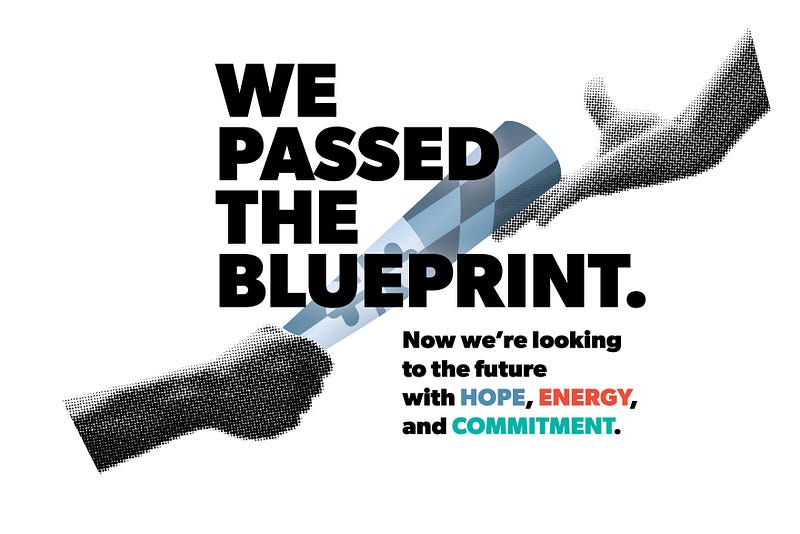
This is truly an uncharted and unsettling time for us as Marylanders, Americans, and citizens of the world. As we celebrate the remarkable work and triumph of the Kirwan Commission’s Blueprint for Maryland’s Future, we must also reflect on its meaning in the new context we’re all adjusting to.
Coronavirus has hit disadvantaged and communities of color particularly hard. It has not served as the great equalizer many suggested early on; indeed it has and will show even more starkly the inequities that exist across Maryland and underline the urgency of the supports and opportunities the Blueprint so dynamically offers our students, families, educators, and communities.
Governor Hogan vetoed the Blueprint for Maryland’s Future on May 7 — just when students, educators, and families need support the most. Click here to urge your legislators to override this veto at their next session.

“We look to the future with hope or a brighter day and the much-needed support that this win will mean for educators and students,” said Cheryl Bost, MSEA president. “We deeply appreciate the work of both houses of the General Assembly to pass the Blueprint and lay the groundwork for the long-term success of our students and economy.
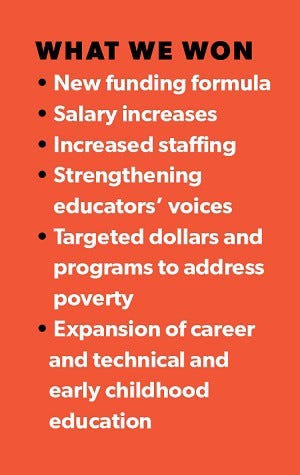
“This truly is the once-in-a-generation commitment we fought for over three years and we need it now more than ever. The governor’s veto won’t stop us — the last step is for our friends in the state legislature, who saw past party divides and passed the Blueprint, to override the veto and put us back on course.”
The Blueprint for Maryland’s Future Works for Kids, Families, Communities, and Our Futuremseanewsfeed.com
The Backstory
The Blueprint is the most significant education bill since 2002 and its thoughtful implementation will be key to the future success of our state’s children and economy. It was the work of the Thornton Commission, and its chair, Alvin Thornton, that led to the Bridge to Excellence, the landmark legislation that infused Maryland schools with increased funding from 2003–2008. This led to Maryland schools showing consistent improvement and steady increases in staffing and salaries.
But progress slowed following the Great Recession and during that time, Maryland began to see significant increases in the general student population, students living in poverty, students receiving special education services, and students with English as a second language. Funding levelled off and class sizes grew, salaries stagnated, and student achievement suffered.
When the Kirwan Commission — formally called the Maryland Commission on Innovation and Excellence in Education — started its work, Maryland schools were found to be annually underfunded by $2.9 billion. The commission, headed by Brit Kirwan, a former chancellor of the University of Maryland system, was charged in 2016 with “making recommendations on how to prepare students for college or the workforce so they can meet the challenges of a changing global economy.” The 25-member group, which included David Helfman, MSEA’s executive director, and other public school stakeholders, studied high-performing school systems around the world and in the U.S.
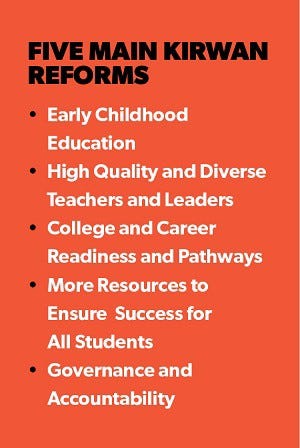
Their recommendations, presented in January 2019, included proven measures such as expanding career technical education, community schools, and pre-k; increasing educator pay; hiring more educators to increase individual attention for students and to expand teacher planning and collaboration time; and providing more support for special education and mental health services.
The recommendations were costed out and then sent to the funding formula workgroup, which included Sean Johnson, MSEA assistant executive director for government affairs, to develop a new school funding formula to implement these measures. The workgroup’s plan was approved by the full Kirwan Commission in late 2019 and formed the basis of the Blueprint for Maryland’s Future bill considered, and ultimately approved, by this year’s General Assembly.
The passage of this year’s Blueprint bill sets the ten-year implementation of the Kirwan recommendations with a new funding formula to support them. It builds on the the General Assembly’s passage last year of phase one of the Blueprint. That infused schools with $1.1 billion over three years, beginning this year. Much of this increase was funded by the passage of Fix the Fund/Question 1 in 2018 that ensured casino revenues would fund increases in school funding.
“Our success in passing Fix the Fund/Question 1 demonstrated to the General Assembly that there was indeed the will and the revenue for us to tackle the funding needs of the larger Blueprint,” said Bost. “Our campaigns — especially around Fix the Fund and our historic March for Our Schools — let everyone know that educators were serious about the need for more resources and staffing for special ed, mental health, community schools, and better salaries and staffing to not only serve our students better, but to recruit and retain great educators who will be there for the next generation of Maryland students.”
What the Bill Means for Students and Educators
Early Childhood Education
Every educator knows that a critical foundation for student success is their access to early childhood education. The Blueprint’s commitment to high-quality early childhood education helps level the playing field for students in every zip code in Maryland.
First, it expands voluntary free full-day pre-kindergarten for three- and four-year-olds whose families fall below 300% of the poverty level. (The poverty level is an income of $26,200 for a family of four — 300% of that is $78,600.) The second tier uses a sliding scale to determine a small cost for families between 300% and 600% of the poverty level.
This year, the process started — with conversion of more half-day pre-k programs to full-day for four-year-olds. The 2020 legislature amended the 2019 Blueprint schedule to fund both tiers for four-year-olds in 2023, three years early. This funding changes the game for young learners whose early start is essential. Expansion is added by private providers (who are slated to provide up to 50% of the needed slots by 2025) and the Built to Learn Act, which makes construction of pre-k classrooms a priority.
To further support families and young learners, the Blueprint funds the important Judy Centers, the Infant and Toddlers Program, and other respected community-based family services programs.
High Quality and Diverse Teachers and Leaders
Throughout the Kirwan Commission’s work, MSEA ensured that the voice of educators was part of the conversation. Understanding how educator salaries, professional autonomy and respect, student discipline, equitable resources, and more affect the classroom experience for both educators and students was essential to the commission’s study and it brought a new consciousness to what the profession is and should be.
To address the pay disparity among teachers and similarly credentialed professionals in the U.S. and those in the highest-performing school systems in the world, the Blueprint raises salaries by 10% between 2019 (when phase 1 of the Blueprint funded salary increases by up to 4.5%, including a 1.5% contribution by each local school system) and 2024. The bill sets the starting salaries for all teachers at a competitive $60,000 no later than July 2026. Many support staff saw raises in 2019 thanks to additional Blueprint funding, and further funding should continue to create these opportunities and increases for support staff at the bargaining table.
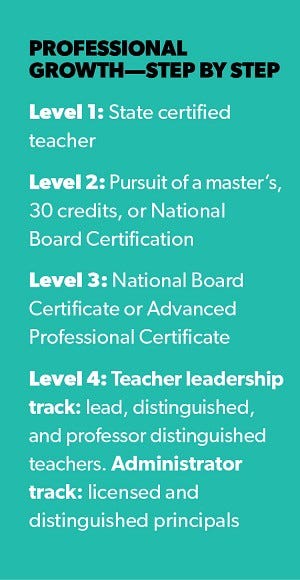
Further opportunities for both pay increases and professional growth come in the form of a four-tiered career ladder. Now, earning more money and building status within the profession no longer means leaving the classroom.
For example, National Board Certification (NBC) and Advanced Professional Certification (APC), level two on the career ladder, come with a $10,000 salary increase. While NBC/APC (level 3) and distinguished teacher status (level 4) come with the highest pay increases, there are a total of eight career ladder pay increases above level three — from $6,000 to $15,000 — for status attainments like becoming a lead, distinguished, or professor distinguished teacher. These pay increases are cumulative per teacher and are in addition to a teacher’s salary.
“The career ladder allows for advancement within the teaching ranks, but we will be keeping a close eye on the nuances of its implementation,” said Bost. “While ultimately there will be a small number of slots available at the top rungs of the ladder, we need to make sure that the process to achieve that distinction is fair, equitable, and makes sense for each local school system.”
Another welcome opportunity for professional growth in the Blueprint is the increase in collaboration time educators will have with one another — an important learning from the Commission’s study of high-ranking school systems.
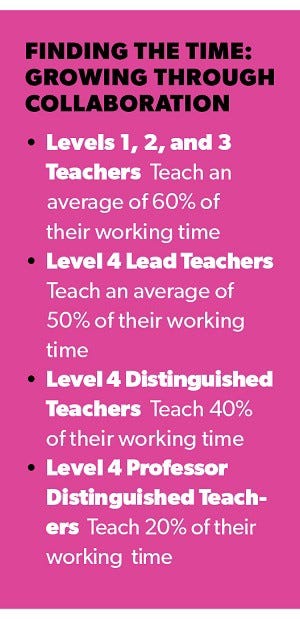
All of this opportunity comes with support. Since 2010, MSEA has offered National Board candidates the Jump Start Program for initial and advanced candidates as well as supports for candidates for certificate renewal. MSDE must now develop an NBC support program to encourage participation as well as a new professional development system supporting the career ladder by July 2023, which local county boards will deliver by June 2025.
In a vitally important development, the Professional Standards and Teacher Education Board (PSTEB) is newly empowered to the benefit of educators. Now PSTEB, which is made up of actual educators and is chaired by Montgomery County Education Association President Chris Lloyd, and the State Board of Education, which is mostly made up of non-educator political appointees, must agree on rules and regulations related to teacher licensure and certification.
College and Career Readiness (CCR) and Pathways
Beginning in the 2021–2022 school year, each local will implement a system that starts in 9th grade that measures student progress toward graduating on time meeting the CCR standard.
Career and technical education (CTE) is taking a step into the spotlight as the Kirwan Commission recommends expansionmseanewsfeed.com
The standard, based on language arts, math, and science, allows a student to begin college or postsecondary education at a community college. If a student can’t meet the CCR standard by 10th grade, the local school system must provide the student with a program of instruction that will get them on level as soon as possible. Once CCR is attained for any student, they must be provided free access to pathways to success — advanced placement, International Baccalaureate, dual enrollment, or other pathways to career certifications or credentials.
CCR addresses the needs of high-achieving students, too. For middle and high school students, local systems will have in place opportunities for enrolling in the next most rigorous course and other pathways to reach CCR before the 10th grade; the system must also pay 75% of the cost of tuition when a student is dually enrolled.

Expectations that every student wants to or should go to college post high school have finally been recognized as leaving many talented students, local businesses, and communities behind as pools of talent for local, well-paying jobs dried up. The Blueprint revitalizes career and technical education programs (CTE) by aligning them with the CCR and the CTE programs adopted by the local board, the State Board, and community colleges. The Blueprint will help to fund a large-scale expansion of CTE programs across the state, opening up a variety of new industry-specific programs to help prepare students for the jobs of tomorrow.
The latest from MSEA polls of members and the publicmseanewsfeed.com
More Resources to Ensure Success for All Students
This is all about equitable funding for all students no matter their zip code. In the Blueprint, the new funding formula increases the foundation formula and the weights associated with compensatory education, special education, and English language learners — all areas educators agree need the most support.

A new concentration of poverty grant program supports intensive services for students in schools that have a high concentration of student poverty and provides them school-based personnel and per pupil support to fund wraparound services. Grants, based on the school’s FARMS rate, provide $260,000 to fund a community schools coordinator and a school-based health care practitioner. These grants will be delivered directly to the school by the state, avoiding any chance for the funding to be redirected prior to reaching the school. Further personnel grants are provided based on schools’ concentration of poverty levels.
“One of the most upsetting findings of the Kirwan Commission was that Maryland has been funding higher-poverty schools at lower levels than schools in more affluent communities. This is inequitable and wrong, and the Blueprint attacks this problem with precision by delivering additional resources to the specific schools that need them most,” said Bost.
Thanks to funding from the Blueprint, at full implementation nearly one-third of Maryland schools will be community schools — representing one of the largest national expansions of the successful community schools model to date.
Governance and Accountability
The Blueprint is deeply researched, complex, and far-reaching legislation — it’s historic, nuanced, and interwoven — and so it requires faithful execution to reap its rewards.
“The Blueprint’s vision for our schools won’t come to fruition if we only implement the pre-k expansion but not the CTE expansion, or the staffing increases but not the salary increases,” said Bost. “Strong accountability will make sure that the money goes where it is intended — to our classrooms and students for the programs and support we need.”

We’ve all seen haphazard, incomplete mandates that provided little guidance and even less accountability for the resources and staffing to carry them out. The Blueprint includes an important Accountability and Implementation Board (AIB) made up of seven members appointed by the governor (from a list supplied by a nominating committee) and serving six-year terms.
The AIB will ensure quality implementation of the Blueprint by designating expert review teams (ERTs) who will join local educators and school boards in assessing compliance with the Blueprint and looking for improvements. The ERTs will be made up of 12 members — teachers, school leaders, and others with expertise who will visit 10% of Maryland schools per year. For career and technical programs, separate ERTs will make recommendations. Until 2025, ERT reports are advisory; in 2025, they become the basis for funding decisions.
The AIB is the entity that will create a statewide implementation plan for the Blueprint and approve the plans of individual local school systems. Those plans must be ready by February 2021 and submitted by June 2021 to be approved by MSDE and the AIB.
What’s Next for the Blueprint?
On May 7, Governor Hogan vetoed the Blueprint legislation. Now the General Assembly will need to reconvene to vote to override the governor’s vote — either in a special session or during their regular session next January. Click here to urge your legislators to override this veto at their next session.
“Recent weeks have only magnified the existing inequities that our students face every day and that challenge their ability to succeed in school,” said President Cheryl Bost. “We must come together to end the fact that too many students and communities have been underserved for too long. The Blueprint is our pathway to do just that — and our students need the help now more than ever.”
Senate President Bill Ferguson, a former high school teacher, told members at MSEA’s second teletown hall on April 21 that he believes in the bill. “Let me be crystal clear that I think that the Blueprint is more important today than it ever has been. From day one, it was never about what we were going to do tomorrow, it was about setting out a vision that is achievable.
“The disparities that existed before this crisis are being exacerbated amongst students,” Ferguson continued, “amongst families, amongst educators, and amongst professionals. The weaknesses in our school system … since schools have been closed have really exposed a lot of the things that [educators] have talked about for years.”

